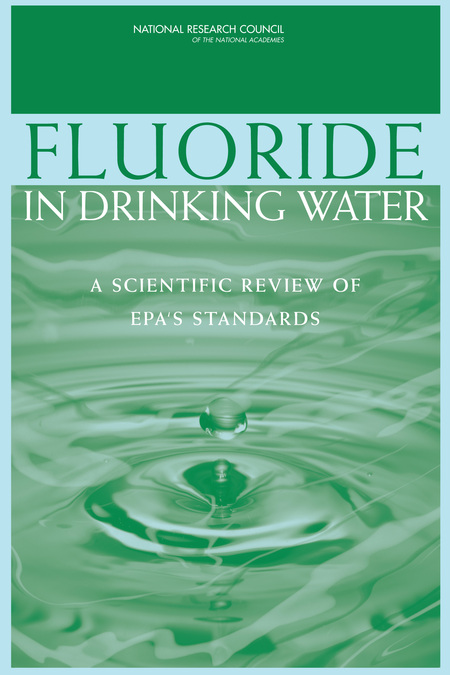QUOTATIONS from the National Research Council (NRC) 2006
EVIDENCE BASED QUOTATIONS of EFFECT AND HARM
Taxpayor dollars were used by our EPA when they commissioned the National Research Council (NRC) to investigate fluoridation. These quotations came from the NRC in 2006 in the book entitled "Fluoride In Drinking Water: A Scientific Review of EPA Standards (2006)" See and read the book here!
| 'Because of the great affinity between fluorine and aluminum, it is possible that the greatest impairments of structure and function come about through the actions of charged and uncharged AlF complexes (AlFx)." (pg 211 Fluoride in Drinking Water: NRC 2006) |
| "Fluorides also increase the production of free radicals in the brain through several different biological pathways. These changes have a bearing on the possibility that fluorides act to increase the risk of developing Alzheimer’s disease." (Pg. 222 Fluoride in Drinking Water: NRC 2006) |
Neurotoxicty of fluoride from NRC 2006
| Fluorides also increase the production of free radicals in the brain through several different biological pathways. These changes have a bearing on the possibility that fluorides act to increase the risk of developing Alzheimer’s disease. (pg 222 Fluoride in Drinking Water: NRC 2006) |
| Fluorides also increase the production of free radicals in the brain through several different biological pathways. These changes have a bearing on the possibility that fluorides act to increase the risk of developing Alzheimer’s disease. (pg 222 Fluoride in Drinking Water: NRC 2006 |
Anatomical Changes in the Brain
"Studies of rats exposed to NaF or AlF3 have reported distortion in cells in the outer and inner layers of the neocortex. Neuronal deformations were also found in the hippocampus and to a smaller extent in the amygdala and the cerebellum. Aluminum was detected in neurons and glia, as well as in the lining and in the lumen of blood vessels in the brain and kidney. The substantial enhancement of reactive microglia, the presence of stained intracellular neurofilaments, and the presence of IgM observed in rodents are related to signs of dementia in humans. The magnitude of the changes was large and consistent among the studies." (italics added) (pg 222 Fluoride in Drinkinhg Water: NRC 2006)
|
OTHER ENDOCRINE ORGANS
"The effects of fluoride exposure have been examined for several other endocrine organs, including the adrenals, the pancreas, and the pituitary (for details, see Appendix E, Tables E-16 and E-17). Effects observed in animals include changes in organ weight, morphological changes in tissues, increased mitotic activity, decreased concentrations of pituitary hormones, depressed glucose utilization, elevated serum glucose, and elevated insulin-like growth factor-1 (IGF-1). Effects reported in humans include “endocrine disturbances,” impaired glucose tolerance, and elevated concentrations of pituitary hormones. Studies of the effects of fluoride on glucose metabolism and in diabetic animals are discussed below; information on other effects is extremely limited." (Pg 256 NRC 2006)
|
| "The major endocrine effects of fluoride exposures reported in humans include elevated TSH with altered concentrations of T3 and T4, increased calcitonin activity, increased PTH activity, secondary hyperparathyroidism, impaired glucose tolerance, and possible effects on timing of sexual maturity; similar effects have been reported in experimental animals." (Pg 260 NRC 2006) |
Thyroid Function
"Fluoride exposure in humans is associated with elevated TSH concentrations, increased goiter prevalence, and altered T4 and T3 concentrations; similar effects on T4 and T3 are reported in experimental animals, but TSH has not been measured in most studies. In animals, effects on thyroid function have been reported at fluoride doses of 3-6 mg/kg/day (some effects at 0.4-0.6 mg/kg/day) when iodine intake was adequate (Table 8-1); effects on thyroid function were more severe or occurred at lower doses when iodine intake was inadequate. In humans, effects on thyroid function were associated with fluoride exposures of 0.05-0.13 mg/kg/day when iodine intake was adequate and 0.01-0.03 mg/kg/day when iodine intake was inadequate" (Table 8-2). (Pg 262 NRC 2006)
|
| "The conclusion from the available studies is that sufficient fluoride exposure appears to bring about increases in blood glucose or impaired glucose tolerance in some individuals and to increase the severity of some types of diabetes." (Pg 260 NRC 2006) |








